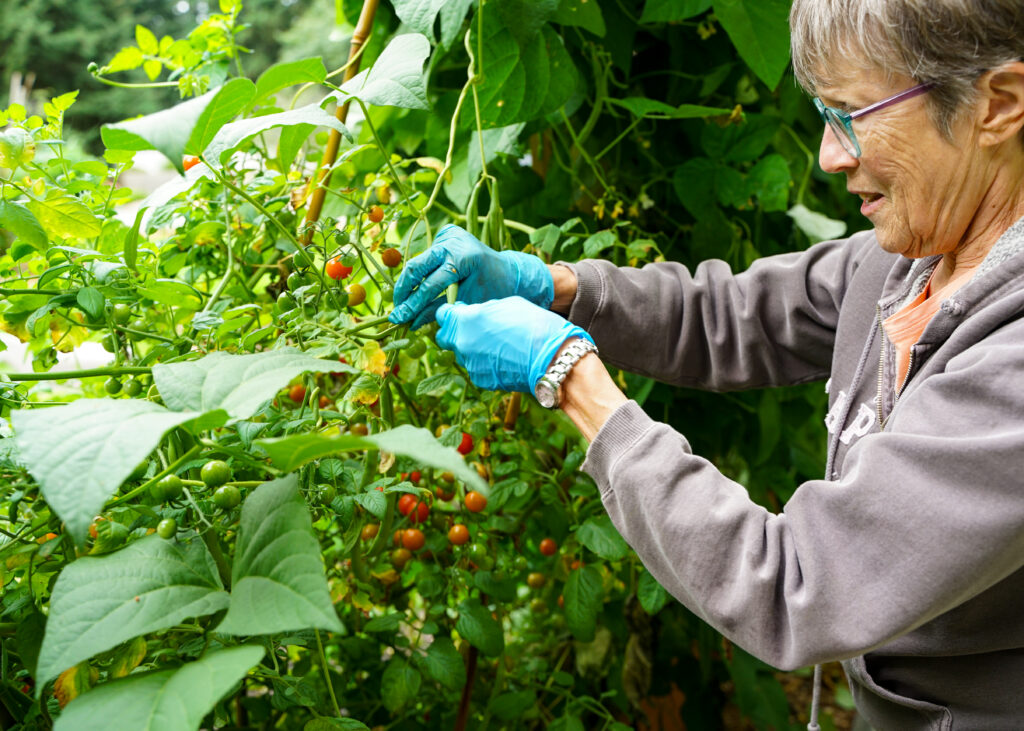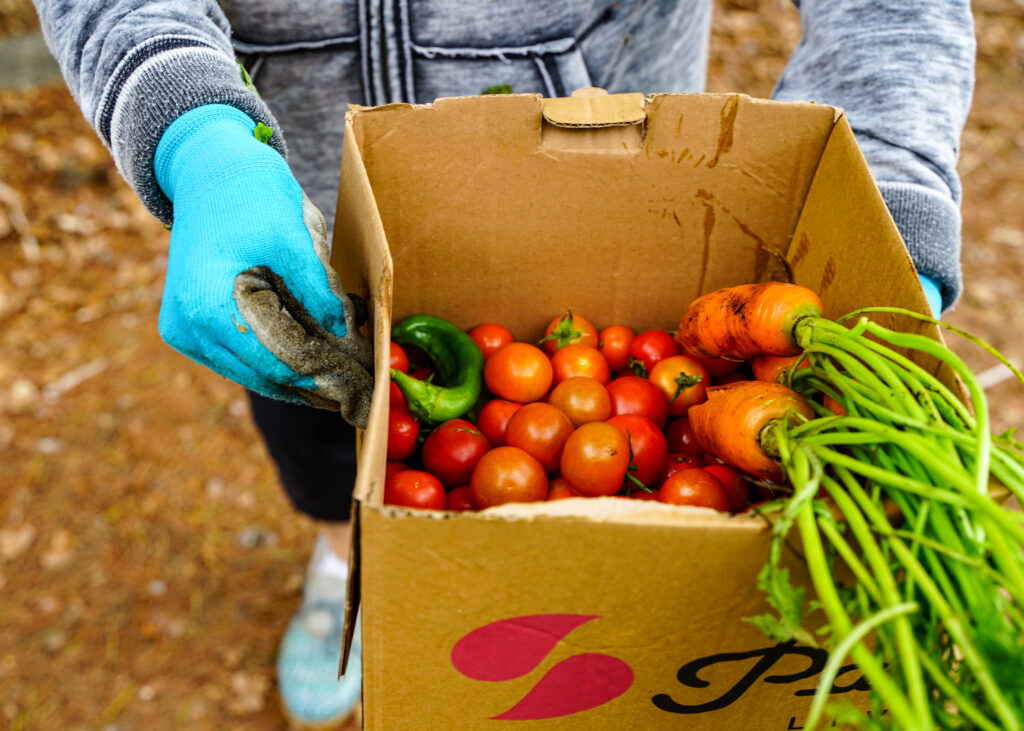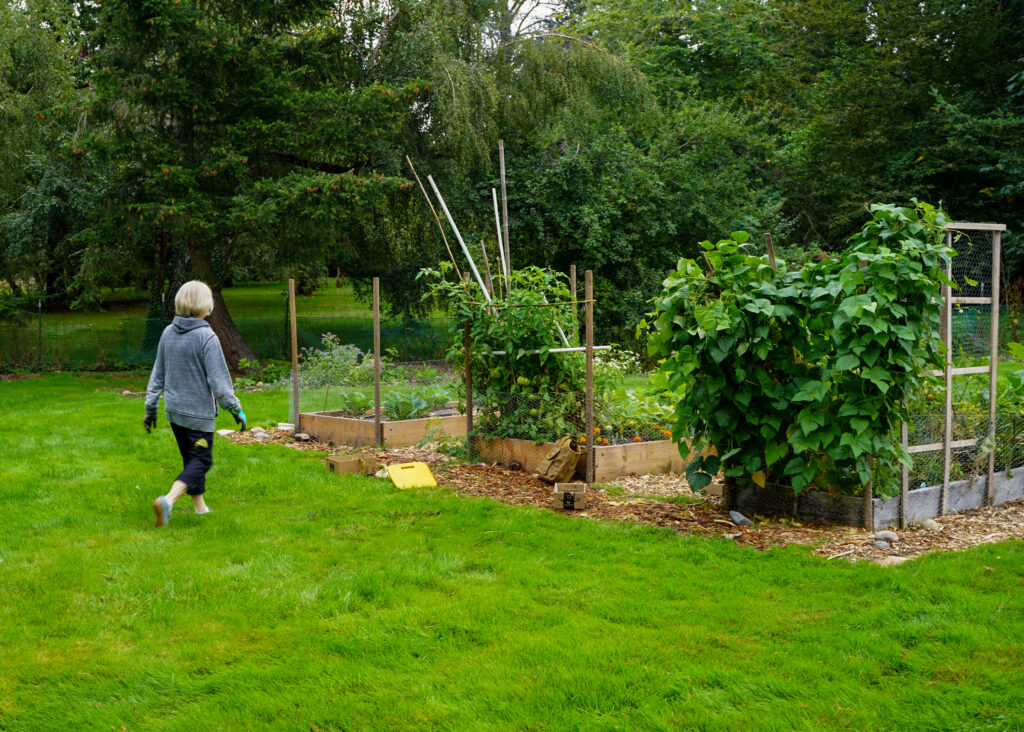Local Gardeners Grow Bounties for Hopelink Food Markets

Photo by Mel Martin for Hopelink.
Behind St. John Vianney Catholic Church in Kirkland, lies three garden beds atop a woodchip base. During gardening season, you can usually find volunteers Kathleen and Jeanne gleaning here. In one glean alone, they harvested 29 pounds of basil, carrots, kale, cucumbers, tomatoes, string beans, squash, and zucchini from the garden, all produce donated directly to the Hopelink Food Market in Kirkland.
With our famously wet winters and mild summers here in the Pacific Northwest, it’s no surprise that the region is teeming with backyard vegetable gardens and P-Patches. But come the end of summer when gardeners are plucking more zucchini than they can handle, Hopelink’s Food Markets are happy to take them off their hands through the Plant a Row, Share a Row campaign.
Established in 2014, Hopelink Harvest is the agency’s farm-direct program, partnering with regional farmers, community gardeners, and gleaning groups to source fresh, culturally relevant produce grown just miles away. In 2023, the program yielded 191,000 pounds of produce.
“Food Markets are the foundation of the Hopelink Harvest program,” says Meghan Moore, Hopelink Harvest Program Supervisor. “The Harvest program builds relationships that allow for farm-direct purchasing and donations, with some growing crops specifically for Hopelink and other food access organizations.”
In 2024, community members from the Social Justice Commission at the St. John Vianney Catholic Church came together to discuss better serving the community. “I just had this idea that maybe we could start a garden and donate all the food to Hopelink,” said Jeanne.
That April, Kathleen and Jeanne began sowing seeds, watching as tomato vines, spindly cucumber plants, and more sprang from the soil. By mid-September, the gardens had produced over 200 pounds of produce, all distributed at Hopelink Food Markets.
“Many people might not realize that donating fresh produce is a viable and impactful way to support food banks*,” explains Jodi Peña, Hopelink Food Program Manager. “When people think of food donations, they often think of canned goods. But there’s a huge opportunity in fresh produce.”
According to Feeding America, Hunger & Poverty in King County, 9.7% of people in King County are experiencing food insecurity and according to our 2022 Community Needs Assessment, the cost of a healthy diet continues to rise.

Along with costs, the U.S. also faces an ever-growing epidemic of preventable diet-related chronic diseases such as cardiovascular disease, diabetes, and obesity. The U.S. Food & Drug Administration (FDA) finds improving nutrition through a healthy diet is one of the most effective public health interventions for reducing these and other chronic illnesses.
Hopelink Harvest’s approach is to enhance its partnership with a diverse range of growers, to include both large-scale contributors and smaller local gardening groups to continue providing fresh, healthy food to our clients.
“Clients want to see all the things you would want to see at a grocery store, so we are working to change the perception that we only provide canned goods,” says Jodi. “We offer 10 to 12 different varieties of produce, a full deli freezer filled with meat, eggs, and milk, and so much more. We’re really trying to meet people where they need to be met nutritionally.”
A bounty of cherry tomatoes and carrots harvested from St. John Vianney Catholic Church’s gardens.
Photo by Mel Martin for Hopelink.
The Harvest program aims to cultivate more garden donors by supporting and facilitating access to resources and knowledge in gardening. “And hopefully, they can support us by donating their produce,” says Meghan.
Efforts in the emergence of donated fresh food options have gone one step further, with both farming partners and gardeners coordinating their production based on the specific needs of Hopelink’s Food Markets.
For example, founded in 2009, Viva Farms is a nonprofit farm business incubator, supporting 35 farm businesses across Skagit and King Counties.
Viva Farms has partnered with Hopelink’s Food Assistance team since 2022 to provide culturally relevant, local, organic produce through bulk purchasing agreements. They coordinate large quantities of produce during peak seasons, helping Hopelink offer seasonal produce throughout the year.

“Viva Farms takes on all of the communication and delivery logistics, coordinating with nonprofits like Hopelink and individual farm businesses who supply produce ranging from mixed vegetables, herbs, and berries,” shared Katherine Myrvold, Sales and Education Manager at Viva Farms. “Usually, Hopelink tells us what they need, and we tell the farmers to begin harvesting. So far, it’s worked pretty smoothly.”
When Kathleen and Jeanne first started gardening for St. John Vianney Catholic Church, their produce included tomatoes, zucchini, squashes, some beans, and peas. “But then we spoke to some of the folks at Hopelink, and they suggested some herbs and some cabbages,” said Kathleen. “With three beds, plus a small garden that the preschoolers started, we’ve really been surprised at what has produced.”
Photo by Mel Martin for Hopelink
The church has now donated herbs including basil, parsley, oregano, sage, and rosemary. Like produce, herbs, and seasonings can be expensive and hard to find at most food banks.
Whether through larger, local farming partnerships like Viva Farms or community-based gardeners like St. John Vianney Church, each contribution makes a huge impact in the lives of many families and individuals experiencing food insecurity.
Thanks to the Harvest program’s innovative approach and community support, fresh produce is becoming more accessible to those who need it most. In the garden, as in life, it’s the blend of creativity and human touch that yields the most fruitful results.
*To offer a more dignified experience, Hopelink renamed its “food banks” to the Hopelink Food Markets in 2021, where people can shop for 100% free food. The Markets are intentionally designed like grocery stores, where people may browse shelves and select what they’d like.
The Hopelink Harvest Program provides fresh, nutritious food options to our community by partnering with local farms and harvest fields located near our five Hopelink Food Markets. If you need food assistance you can sign up through the Hopelink Food Assistance program.
